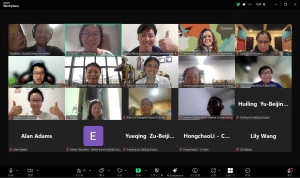
Norbert Hsu is the regional leader of World Vision for the East Asia region. This interview was conducted by CDB’s Gabriel Corsetti on the 29th of November, on the sidelines of the World Philanthropy Forum in Beijing.
China Development Brief: First of all, as World Vision’s regional director for East Asia, could you just give us an overview of what World Vision does around the continent? Which areas does your work cover and what issues are you trying to address?
Norbert Hsu: Absolutely. So there are actually two regions in the Asia-Pacific for our field offices, East Asia and South Asia Pacific. East Asia comprises eight countries: China, Mongolia, North Korea, Thailand, Vietnam, Cambodia, Laos, and Myanmar. In these countries, as in pretty much all of the countries around the world, we work across humanitarian and emergency relief, community-based development and advocacy. In particular, the sectors we work in are health and nutrition, water sanitation and hygiene, education, child protection and livelihoods. So our approach is very much a multi-sectorial integrated approach to ensure child well-being.
CDB: From your perspective, seeing it perhaps from the outside, how do you see Chinese civil society and the struggles it is facing right now?
NH: I believe that overall there are very strong NGOs within China today, but in general I would say that civil society is still in the maturing stage. A lot of local NGOs still have issues today in terms of securing sustainable funding, so they may raise funding one year and then find it becomes very different the next year or the next few years. That makes it difficult for them to really think about how they will plan and move forward with the different programs they have.
Secondly, on the programming side, I think they are still trying to understand what the level of accountability and transparency is that is needed to gain the trust of their donors. So it is important for them to think through the issue of what program quality is and what areas of monitoring and evaluation are important, and ways to ensure the right processes, controls and systems that account for funds appropriately. So in that sense there are still a lot of ways that Chinese civil society and Chinese NGOs can really learn from what’s been practiced internationally.
CDB:The One Belt and One Road initiative, which is part of the theme of the World Philanthropy Forum, is becoming an important component of the Chinese government’s international vision. How does World Vision see this strategy as tying into your programs in Asia and your strategy for the region?
NH: Very much so. I think especially within the one belt and one road initiative, the fifth goal of “people-to-people bonds” is the area where there’s a very strong alignment between our program and China’s Belt and Road initiative. In particular this objective speaks to the desire to build collaboration and cooperation between NGOs, and that’s something we do all the time in terms of helping to build local NGO capacity and working with them in these different countries. In addition, we regularly organise public activities and especially campaigns to raise public awareness on issues concerning children. And lastly, and I think most importantly, we focus on poverty alleviation. This area of how we do long-term community-based development allows us to be able to work with communities on a people-to-people basis, building relationships and working together. So in that way I think there’s a lot of alignment.
I also want to note that a large part of our funding comes through child sponsorship. Child sponsorship is where a donor sponsors a child and gives on a monthly basis to the child in its community. This way a bond is developed over time, as the children report back to the donor about how they’re doing, and the donor writes letters to the children and gets to know their lives and their families. It is really then that the people-to-people bond comes through.
CDB: In the last few years we’ve seen some Chinese NGOs starting to go out, or as the Chinese say “走出去”. The Belt and Road Strategy might help accelerate the trend. As the Chinese companies go to other countries and build infrastructure, there might be misunderstandings or differences with the local people, and Chinese NGOs could perhaps help to smooth the way as intermediaries. Have you noticed an increasing trend of Chinese NGOs working in other countries, and do you think World Vision could provide its support?
NH: Yes, there are starting to be more and more, but I think it’s still in the very early stages, because in a way at this point it is not very clear where the funding will come from. But there are also Chinese companies with CSR, and that probably is happening more readily than Chinese NGOs or going out, so to say.
I do think this is an area where World Vision can really help support the work of these Chinese NGOs. There are just a number of ways off the top of my head in which I think it is possible. World Vision can help provide some training for Chinese NGOs as they consider how to meet international standards, and what are the things they need to consider in terms of going out. We can also help think about how to fund the work by either writing proposals together, jointly working together as a primary funder and a subprime one, so to say, and generally finding ways to go after funding together. And thirdly, we can think about how to work together within those countries. As Chinese NGOs move into these different contexts, providing them a better understanding of the context, working together and being able to really affect change are important. I mean ultimately I think that’s the purpose of all these Chinese NGOs, not necessarily to smooth things over, but to be able to really focus on that fifth “people-to-people bonds” objective, and poverty alleviation in all areas.
CDB: I see. What countries in East Asia do you think World Vision will have a special focus on in the next few years? What do you think your programs are going to have an especially big impact on?
NH: I think all these countries are important because they all have a high concentration of vulnerable children. So that’s our main focus. We are committed to helping the most vulnerable children. So where we are going to increase our resources is areas where we can do long term community-based development with vulnerable children, and areas where we can provide humanitarian emergency relief. That second portion tends to be a lot more unpredictable. If a big emergency relief occurs, we fundraise according to that specific situation. For long term community-based development, it’s something where we strategise to ensure that we have an appropriate footprint, and resources to match that footprint in time.
CDB: World Vision is an organisation which focuses a lot on children. I know World Vision also organises educational centres around China. In view of the recent child abuse scandals in Beijing and Shanghai kindergartens, do you think World Vision could help Chinese society set new standards in this field to address this sort of issue?
NH: Yeah. We are very much focused on child protection, and specifically in a lot of countries right now, on how to end violence against children in the home and schools. That’s one area in which we believe we have a lot of expertise in at this point. When it comes to what happens in terms of a specific nursery or center, I think there is some work we have done in China. We work with both left-behind children and with children who have been abandoned. We have centres in rural areas which work with left-behind children, and other centres in cities where homeless or abandoned children come, and we have staff that helps to work with the government and with the parents to ensure that they can get back home. We saw that as a gap in the current social services system. We have pretty strict standards around child protection and norms. We would be happy to contribute in this sense.
We helped to translate the Minimum Standards for Child Protection, and I think it was finished in June. It was officially introduced to China after the translation. We are still trying to help more Chinese NGOs and organisations that work with children to understand the standards and implement the standards in their work. We worked on it with other INGOs, including Save the Children and Oxfam. We are still figuring out how we could better conduct training around it.
We are very committed to this area. World Vision as an organisation is excited to be here. We’ve had a long history in China, officially since 1993. We are committed to continue to serve children and families.



